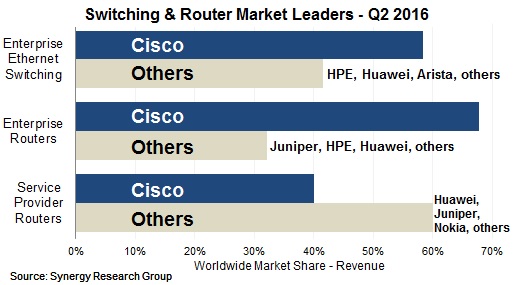
Cisco’s share of the total worldwide switching and router market was 53%, with shares in the individual segments ranging from 68% for enterprise routers to 40% for service provider routers according to Synergy Research.
For the last four quarters in aggregate Cisco’s market share was 55%, a percentage point down from the preceding four quarters. Behind Cisco the ranking of vendors was different in each of the three main segments but in aggregate Cisco is followed by Huawei, Juniper, HPE and Nokia.
Their overall switching and router market shares were in the 5-9% range in Q2. There is a reasonably long tail of other vendors but none has an overall market share in excess of 2%.
Worldwide switching and router revenues were over $10 billion in Q2 and were $41 billion for last four quarters, representing 1% growth on a rolling annualized basis. Enterprise Ethernet switching is the largest of the three segments accounting for almost 60% of the total and it is also the segment that is growing the most. In Q2 North America remained the biggest region accounting for well over 40% of worldwide revenues, followed by EMEA, APAC and Latin America. The APAC region has been the fastest growing and this was again the case in Q2, with growth being driven in large part by service provider spending in China, which benefitted Huawei in particular.
“The big picture is that total switching and router revenues are remaining relatively stable at some $10 billion per quarter and Cisco continues to control well over half of the market,” said Jeremy Duke, Synergy Research Group’s founder. “Some view SDN and NFV as existential threats to Cisco’s core business but there are few signs that this is impacting its competitive market position. In Q2 Cisco experienced some weakness in service provider sales and it continues to feel the heat from strong growth of Arista and Huawei in enterprise switching, but overall its dominance is little diminished by the multiple challenges it is facing.”






